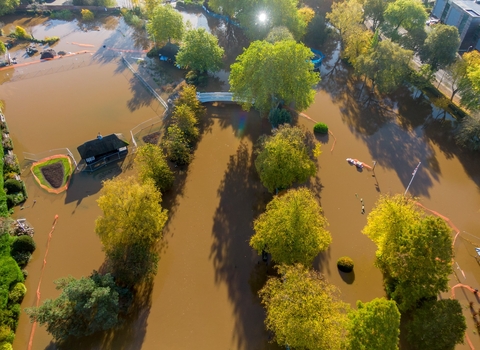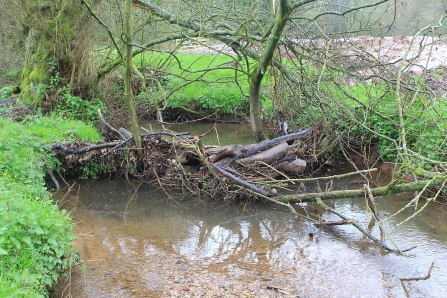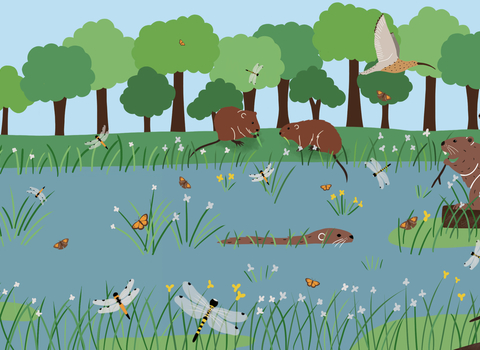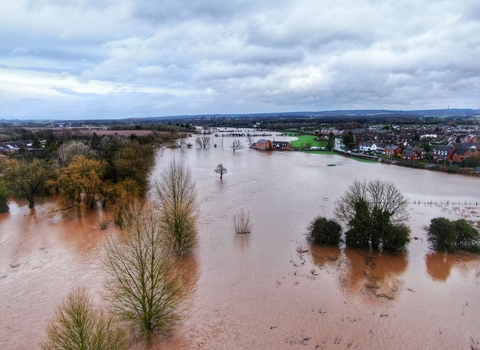Staffordshire faced some of the worst flooding in its history a year ago.....
....but nature can help!
12 months ago Storm Ciara and Storm Dennis brought some of the most disruptive flooding ever experienced across the UK.
In Staffordshire they left widespread distruction in their wake, with the town of Stafford experiencing the worst flooding event in over 20 years.
To mark the anniversary, Staffordshire Wildlife Trust is calling on authorities to ‘let nature help’ mitigate the effects of flooding by investing in Natural Flood Management techniques and we want the public to share their stories, videos and photos of last year's floods to inspire action.

Credit: Stafford Ariel Photography
Share your flood stories and photos
Share your flood photos and stories from last year using our hashtags #slowtheflow and #letnaturehelp to inspire action and create awareness and we will feature some of them on this page and share them on our social media channels. Don't forget to tag us in your posts too! You can find us on Twitter, Facebook and Instagram
We also aim to create a photo collage of all the flooding photo submissions to make an impactful post on our social media channels and create awareness
Example post
"This time last year Staffordshire experienced some of the worst flooding in its history. I am calling on local authorities to #letnaturehelp mitigate the effects of flooding. The flooding [insert your flood story e.g. caused my business to close] #slowtheflow"
How does nature help and what is Natural Flood Management?
Traditional flood management alone will not combat future extreme weather events, we need investment in Natural Flood Management.
NFM is a holistic approach to flood management working at a whole catchment scale. In the headwaters of a catchment leaky dams created by felling trees across a watercourse slow the flow of water whilst also providing habitat. Ponds and reedbeds not only store water but help to clean it too, whilst good management of upland habitats means that our land can act as a ‘sponge’ by absorbing and storing water.

Credit: Nick Mott
In the lower reaches, allowing rivers to reconnect to their floodplains provides enormous water storage areas and amazing habitat. It all works together to delay the time water takes to flow downstream. By slowing the flow and holding water away from homes and
businesses in new wetlands and complex habitats, communities are better protected from the risk of flooding.
You can read more about Natural Flood Management here and download our booklet below to read how we can #letnaturehelp tackle Climate Change issues such as flooding
Let Nature Help -further reading
Flooding memories we've had so far
Here are some of the flood memories from last year that people have been sharing so far
What we are doing to help
In Staffordshire with our support, a number of Natural Flood Management projects are underway and are being delivered in partnership with a wide range of organisations, communities and landowners
Our Natural Flood Management projects
Farming Floodplains for the Future
The Trust has pioneered projects such as ‘Farming Floodplains for the Future’ in 2007, which highlighted how the farmed landscape can be viably managed in ways that reduce flood risk downstream whilst enhancing the natural environment. Since that project, The Trust has gained a reputation for working with private landowners and farmers, and are delivering some innovative projects across the county now.
Small Grants Scheme & Water Environment Grant
In 2020, The Trust were awarded £84,000 from the Environment Agency to set up a Small Grants Scheme in the Marchington Brook catchment, this will see landowners applying for funds to implement Natural Flood Management measures on their land.
A further £55,000 was awarded to start work in the Upper Sow catchments, where engagement with landowners will lead to NFM measures being delivered in priority areas.
A £320,000 Water Environment Grant from the Environment Agency is being put to work in a number of catchments to help improve water quality and restore and create habitats.
Farmer Training Groups
NFM has to be a collaborative approach that works at a landscape scale, so landowners are essential to the success of these projects. The Trust run two farmer training groups, one in the Whiston Brook and one in the Upper Sow. Landowners receive information and practical demonstrations of NFM measures, as well as understanding what the issues are in their catchment and how they can be part of the solution.
Stafford Brooks
The Trust is also part of the multi-million Stafford Brooks project that will see a network of flood alleviation points created through Stafford. Delivery of the project will begin in 2021.
Slowing the Flow
Pressures from climate change and human activity mean that floods have begun to occur more often and when they do occur result in more costly damage. As a result, traditional approaches to flood management are growing less and less effective. Slowing the Flow is a partnership project based in the South West Peak which is working with nature rather than against it in a cost-effective and ecologically sound way.
With our partners at the Cheshire Wildlife Trust we are using a number of techniques that work to restore a river’s natural flood defences to reduce downstream flooding.
We are working with landowners and local residents to identify additional suitable areas for this project and where the impact will be the most far-reaching.
SUNRISE - Sustainable Urban Drainage
We are lead partners on SUNRISE, a £3.6 million scheme set to benefit sixteen urban sites in North Staffordshire by creating new wildlife habitats, improving water quality and reducing flooding. One of the projects within SUNRISE that is based around Sustainable Urban Drainage, creates features, similar to natural flood management (nature-based solutions), that slow and hold water in areas where the increasing amount of tarmac and concrete is making flash flood events more pronounced. We want more of these features in both Stoke and Stafford. We believe features such as pocket parks should be part of urban design

Our ambitious nature recovery mission ever - we need your help!
It is now clearer than ever how vital wildlife and our natural world are to the health, wellbeing and future of all of us.
But nature is in crisis; it's future is uncertain and it needs our help. Over 40 % of wild species have declined since 1970. One million animal and plant species are now threatened with extinction.
We are calling for Nature's Recovery and everyone has their part to play. Nature can help us combat issues such as climate change but we need to help it recover.
We would love to hear what your local wildlife and wild places mean to you and why you want a greener future for Staffordshire. We will forward on your feedback to leaders and key influencers at our Nature's Recovery summit later this year



